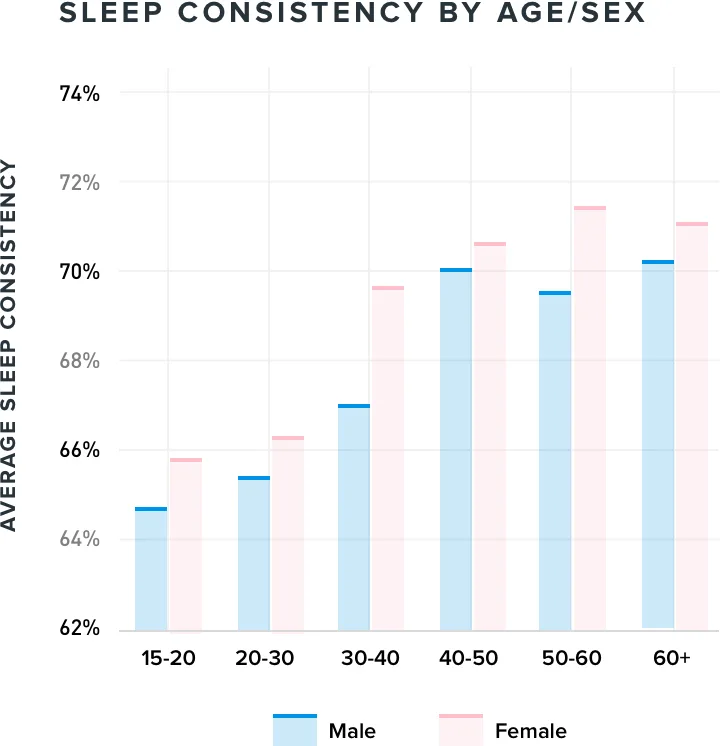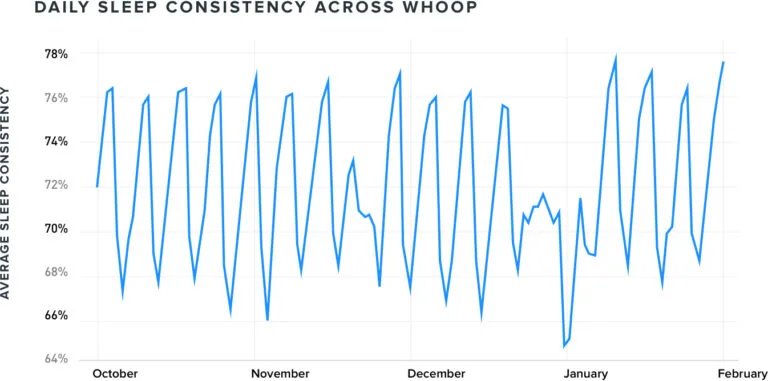Topics
- Article
- Sleep
Sleep Consistency: Why We Track it and How Do You Compare?

Sleep Consistency is something we’ve been talking about for a long time.
The importance of Sleep Consistency is something we’ve been talking about for a long time. It’s highlighted in your weekly performance assessment and used to bring you more intelligent Sleep Need push notifications, and you can also track it each day alongside the rest of your sleep metrics.
WHAT IS SLEEP CONSISTENCY?
Sleep Consistency quantifies how similar your sleep and wake times are over a 4-day period. Scored on a 0-100% scale, higher Sleep Consistency indicates more similar bed and wake times, while lower Sleep Consistency indicates greater variability in night-to-night sleep timing. In the space below, we break down the Sleep Consistency of various WHOOP subpopulations and dig into what our data shows you can expect if you improve your own Sleep Consistency.
WHAT'S NORMAL?
People ask us all the time if their data is “good” or “normal,” and how they stack up against other WHOOP users. To help answer this question, we pulled Sleep Consistency values from the month of January for 25,000 WHOOP users and plotted them in the histogram shown below.

The average Sleep Consistency value across all users on WHOOP is a shockingly low 67.9%. We find this particularly surprising because WHOOP users love their sleep--they get an average of 7.6 hours per night for an average Sleep Performance of 82.8%. This means that while WHOOP users are generally making a good effort to get enough sleep, they aren’t yet doing it optimally. Since we are glass-half-full kind of people, we think this is great news since is means there is a simple and effective path to improvement. Before we get into all the exciting correlations we found between various measures of sleep quality and Sleep Consistency, we first want to show you that not all subpopulations on WHOOP are doing equally poorly. Some of you are actually nailing your Sleep Consistency, while others have more opportunity to improve.

When divided into different age cohorts roughly by decade, we observe that sleep consistency gets better as WHOOP users get older. The increase is roughly one percentage point per decade, with the biggest improvements made as users leave their potentially rowdy 20s behind them for the likely more stable and responsible 30s.

When we further broke down our age cohorts by gender, we observed that females are more consistent sleepers across the board. The higher commitment to consistent sleep timing seems to be paying off. In addition to having significantly higher Sleep Consistency than males, females also have a much better average Sleep Performance--85.8% compared to 81.5%.
SLEEP CONSISTENCY TEMPORAL PATTERNS
Similarly to what we reported on with Sleep Efficiency, Sleep Consistency exhibited a robust cyclical behavior which broke down over Thanksgiving weekend and again during the holiday season from the end of December through New Years.

We found that the cyclic nature of WHOOP Sleep Consistency almost directly aligned with the weeks of the year. This phenomenon can be better visualized when data is binned by day of week.

WHY CARE?
Here comes the meaty part - if you’re on WHOOP, you probably have a pretty good sense of your Sleep Consistency from your Weekly Performance Assessments (WHOOP members can jump to theirs here). And now that you have an understanding of how you measure up to the rest of the WHOOP population, you’re probably wondering what you can do to get better.
MORE SLEEP!
We mentioned above that females, who on average have higher Sleep Consistency than males, are also getting more sleep. Well, it turns out that this is also true on an individual level. WHOOP users who sleep more consistently are also sleeping more overall. In fact, our most consistent sleepers (those averaging Sleep Consistencies above 80%) are getting roughly 1.25 hours more sleep per night than are our least consistent sleepers (those averaging Sleep Consistencies below 50%). The relationship between Sleep Consistency and Duration is further detailed in the graph below.

BETTER SLEEP!
Not only are highly consistent sleepers getting more sleep, they are getting better sleep too! Our most consistent sleepers have higher Sleep Efficiency, and get more SWS and REM Sleep (Note: throughout the images that follow we cut off the graphs for Sleep Consistencies below 48% and above 85% because so few users averaged values in those ranges that the resulting analysis was not statistically significant).

Sleep Consistency explains up to a 3% difference in Sleep Efficiency. For those of you who are motivated to sleep more efficiently after reading last week’s post, this data suggests that sleeping more consistently is a great place to start.

Slow Wave Sleep (also known as deep sleep) is primarily characterized by physical recovery. Sleep Consistency can explain about a 15-minute difference in Slow Wave Sleep per night. While this is an exciting difference, the impact of increasing Sleep Consistency on REM sleep is even greater. As shown in the graph below, Sleep Consistency explains up to a 36-minute difference in nightly average REM sleep, the phase of sleep in which mental recovery occurs.

WHAT OUR MEMBERS SAY
We recently surveyed our 100 best sleepers on WHOOP for their tips and tricks for peak Sleep Performance. Additionally, we asked them to rank the importance of “maintaining a consistent bedtime” on a scale of 1-7. A full 78% of them scored the importance of sleeping at consistent times each day as 6 or 7 (maximally important), and no one ranked it below 4 (neutral).